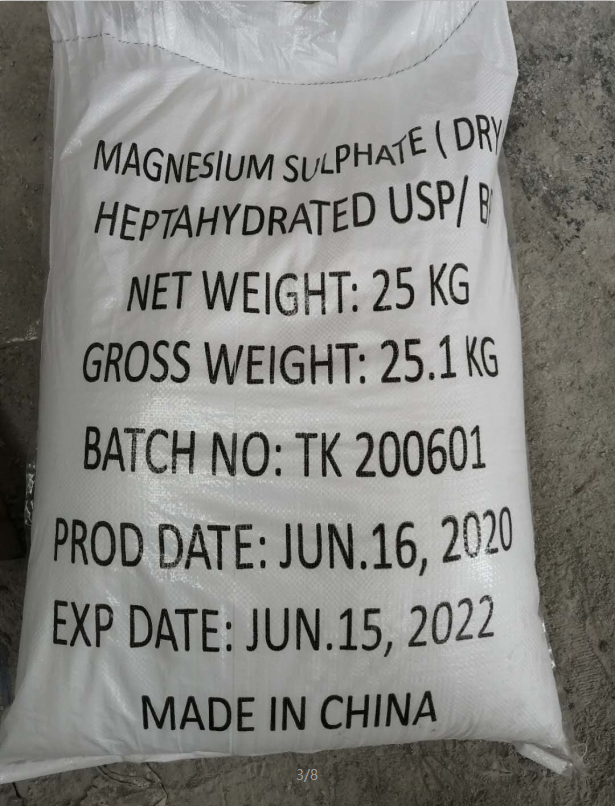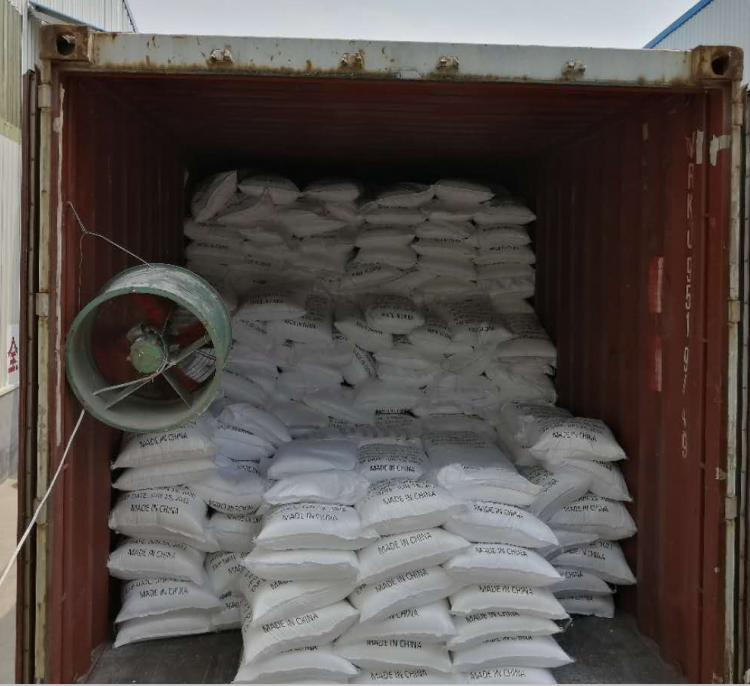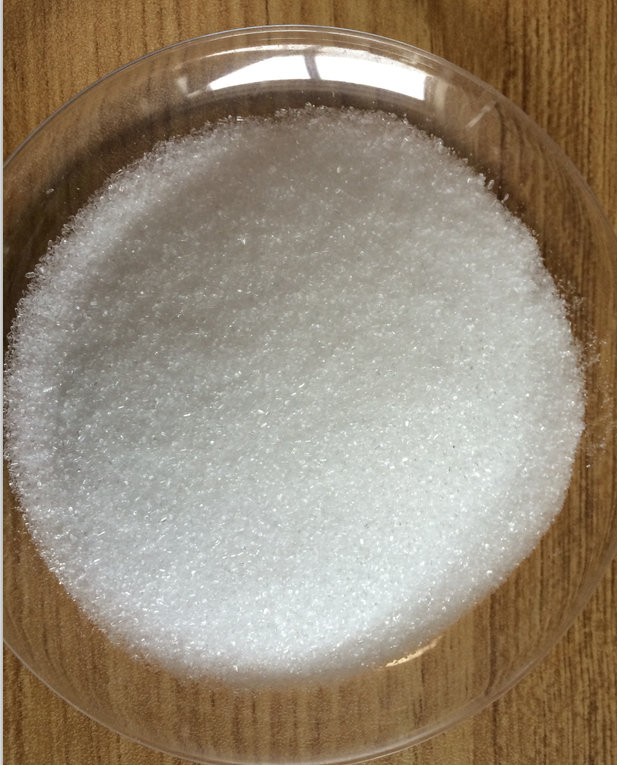Product name Magnesium sulfate heptahydrate
There are industrial grade, food grade, and pharmaceutical grade. The particle size is determined according to customer needs.
七水硫酸镁(分子式MgSO4·7H2O)又名硫苦、苦盐、泻利盐、泻盐, 为白色或无色的针状或斜柱状结晶体,无臭,凉并微苦,分子量: 246.47,比重1.68,易溶于水,微溶于乙醇和甘油,在67.5℃溶于自身的结晶水中。Decomposed by heat, the crystal water loses four molecules at 70℃ and 80℃. It loses all crystal water and becomes anhydrous at about 200℃.It is easily weathered into powder in the air (dry). When heated, the crystal water is gradually removed to become anhydrous magnesium sulfate. This product does not contain any toxic impurities。Because magnesium sulfate heptahydrate is not easy to dissolve, it is easier to weigh than anhydrous magnesium sulfate, which is convenient for quantitative control in industry. Mainly used in the manufacture of fertilizers, leather making, printing and dyeing, catalysts, paper making, plastics, porcelain, paints, matches, explosives and fireproof materials. It can be used for printing and dyeing thin cotton cloth and silk, as a weighting agent for cotton silk and as a filler for kapok products;Used in medicine as Epsom salt.
【Basic information】
Chinese name | Magnesium Sulfate Heptahydrate | English name | magnesium sulfate heptahydrate |
Nickname | Sulfur; Bitter salt; Epsom salt; Epsom salt | Chemical formula | MgSO4·7H2O |
Molecular weight | 246.47 | Exterior | White powder |
CAS Registry Number | 10034-99-8 | EINECS registration number | 231-298-2 |
Melting point | 1124℃ | Water soluble | H2O: 1 M at 20 °C, clear, colorless |
Density | 1.68 | Hazard symbol | Xi |
【Physical and chemical properties】
Physical properties
外观与性状:属斜方晶系,为四角粒状或菱形晶体,无色、透明,集合体为白色、玫瑰色或绿色玻璃光泽。形状有纤维状、针状、粒状或粉末。无臭、味苦。
Solubility: easily soluble in water, slightly soluble in ethanol and glycerin.
Chemical nature
Stability: stable in moist air below 48.1℃, easy to weather in warm dry air, when it is higher than 48.1℃, it loses 1 crystal water and becomes magnesium sulfate hexahydrate, which is soluble in crystal water at 67.5℃ At the same time, magnesium sulfate monohydrate is precipitated. At 70~80℃, 4 crystal water is lost, 5 crystal water is lost at 100℃, 6 crystal water is lost at 150℃, and all crystal water is lost at 200℃. Powdery anhydrous magnesium sulfate, the dehydrated substance is placed in moist air to re-absorb water. In a saturated solution of magnesium sulfate, hydrated crystals with 1, 2, 3, 4, 5, 6, and 12 water can be crystallized, and magnesium sulfate dodecahydrate can be precipitated in a saturated aqueous solution at -3.9 to 1.8°C. Magnesium sulfate heptahydrate is precipitated in saturated aqueous solution at -1.8~48.18℃, and magnesium sulfate hexahydrate is precipitated in saturated aqueous solution at 48.1~67.5℃. Magnesium sulfate monohydrate is precipitated when it is higher than 67.5℃. Magnesium sulfate hexahydrate is at 87~92. Dissimilar melting occurs between ℃ and produce magnesium sulfate pentahydrate or tetrahydrate. Magnesium sulfate tetrahydrate is converted into magnesium sulfate trihydrate at 106°C. Magnesium sulfate trihydrate is converted into magnesium sulfate dihydrate and dihydrate at 122~124°C. Magnesium sulfate is converted into stable magnesium sulfate monohydrate at 161~169°C.
Toxicity: Toxic
pH value: 7, neutral
【The main purpose】
food
As a food fortifier. my country stipulates that it can be used in dairy products with a usage amount of 3-7g/kg; the usage amount in drinking liquid and milk beverages is 1.4-2.8g/kg; in mineral beverages, the larger usage amount is 0.05g/kg.
industry
It is often used in combination with calcium salt in the water for wine mothers. Adding 4.4g/100l of water can increase the hardness by 1 degree. If it is used more, it will produce bitterness and produce hydrogen sulfide odor.
Used as tannery, explosives, paper-making, porcelain, fertilizer, oral laxatives for diagnosis and treatment, and mineral water additives.
agriculture
Magnesium sulfate is used as a fertilizer in agriculture because magnesium is one of the main components of chlorophyll. Usually used for potted plants or crops that lack magnesium, such as tomatoes, potatoes, roses, etc. The advantage of magnesium sulfate over other fertilizers is its higher solubility. Magnesium sulfate is also used as a bath salt.
【Precautions】
Risk overview
Health hazards: Irritating to eyes and ~. Basic~.
Environmental hazards: Hazardous to the environment and can cause pollution to the atmosphere.
Explosion hazard: This product is non-flammable and irritating.
Others: This substance is harmful to the environment, so special attention should be paid to the pollution of the atmosphere.
Risk term
Term: S24/25
Danger sign: R36/37/38
Storage and transportation characteristics
Transportation considerations: The packaging must be complete when shipping, and the loading must be secure. During transportation, ensure that the container does not leak, collapse, fall, or be damaged. Mixed shipment and transportation with acids and edible chemicals are strictly prohibited. Avoid exposure to the sun, rain, and high temperature during transportation. The vehicle should be thoroughly cleaned after transportation.
Handling and storage
Operation precautions: airtight operation, strengthen ventilation. Operators must undergo special training and strictly abide by operating procedures. It is recommended that operators wear self-priming filter dust masks, chemical-protective glasses, anti-poison penetration overalls, and rubber gloves. Avoid generating dust. Avoid contact with acids. Lightly load and unload during transportation to prevent package damage. Equipped with leakage emergency treatment equipment. Empty containers may be harmful residues. When the dust concentration in the air exceeds the standard, a self-priming filter dust mask must be worn. When emergency rescue or evacuation, you should wear a gas mask.
Precautions for storage: Store in a cool, ventilated warehouse. Keep away from fire and heat sources. It should be stored separately from acids, etc., and avoid mixed storage. The storage area should be equipped with suitable materials to contain the leakage.
first-aid
Contact: Take off contaminated clothing and rinse with plenty of running water.
Eye contact: Lift the eyelid and rinse with running water or saline. Seek medical attention.
Inhalation: Leave the scene to fresh air. If breathing is difficult, give oxygen. Seek medical attention.
Ingestion: Drink enough warm water, induce vomiting, and seek medical attention.
Emergency treatment
Isolate the contaminated area and restrict access. It is recommended that emergency treatment personnel wear dust masks (multi-faceted covers) and protective clothing. Avoid dust, sweep up carefully, put in a bag and transfer to ~ place. If there is a large amount of leakage, cover with plastic sheet or canvas. Collect and recycle or transport to waste disposal sites for disposal. If it leaks, after neutralization, use ~ burying method.


